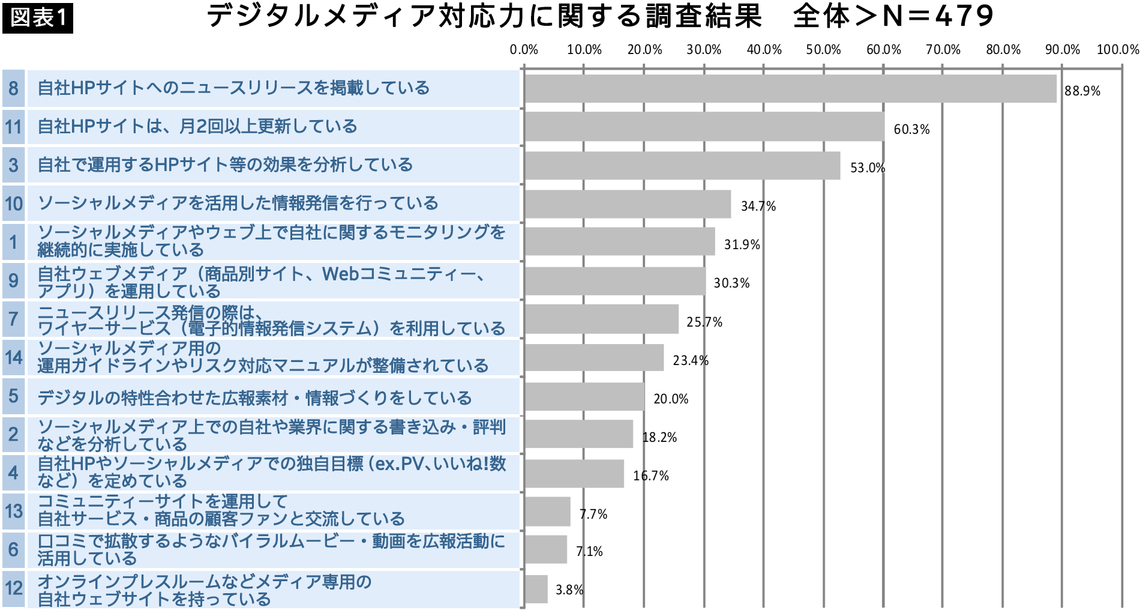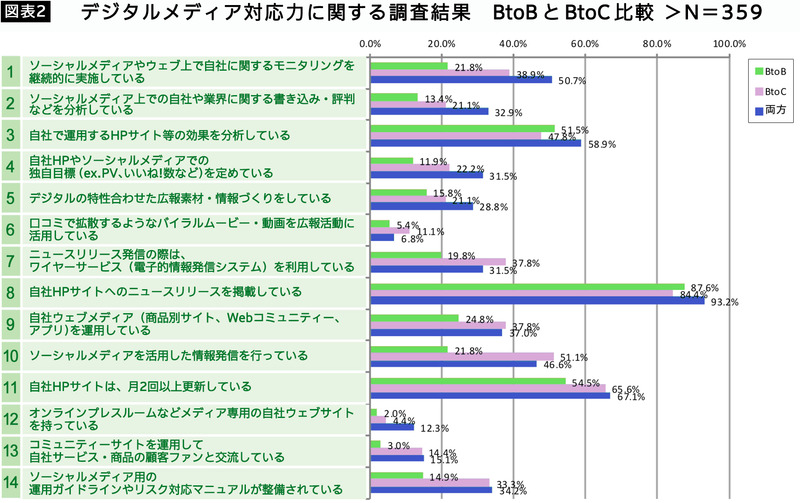While mass media was once the primary focus for public relations departments, the proliferation of corporate websites and social media, along with the emergence of diverse online media formats ranging from portals to aggregation sites, has made digital media management a critical function for PR departments. PR professionals are now expected to manage corporate accounts on platforms like Facebook and Twitter, disseminate positive information about their company across online media (especially social media), and monitor for negative coverage.
Therefore, in our institute's " First Survey on Corporate Public Relations Activities" targeting 479 listed companies in Japan, we prepared 14 questions to understand the current state of digital media capabilities within PR departments. Here are the results.
■ Increasing Use of Digital Media for Information Dissemination
Figure 1 ranks the survey results by the number of responses received. The top three responses were: "Posting news releases on the company website" (88.9%), "Updating the website at least twice a month" (60.3%), and "Analyzing the effectiveness of the company website" (53.0%). This indicates that company websites are widely used as a means of disseminating corporate information, and that analyzing their effectiveness is also relatively common. Furthermore, "using social media for information dissemination" and "operating proprietary web media (product-specific sites, web communities, apps)" both exceeded 30%, indicating that many companies utilize owned media beyond their corporate website as communication tools. Focusing specifically on B2C companies, 51.1% (over half) use social media for information dissemination (Figure 2), demonstrating the progress in utilizing social media for PR.
■ Operational Guidelines and KPI Setting Still in Progress
Conversely, only 23.4% of companies have "established social media operational guidelines or risk response manuals" (Figure 1). This indicates that while companies use social media for information dissemination, many lack the necessary defensive measures like guidelines. Since social media, which enables direct communication with consumers, carries risks such as backlash, it is generally advisable to prepare for such risks. Furthermore, only 16.7% of companies "set unique goals for their own websites and social media" (Figure 1), suggesting the difficulty of establishing KPIs for owned media operations.
■ Information Creation Tailored to Digital Media Characteristics Remains Minority Practice
Regarding information creation, only 20.0% of companies "create PR materials and information tailored to the characteristics of digital media" (Figure 1). When aiming to spread word-of-mouth on social media, edgier, easily shareable content—different from the official tone used for mass media—is effective. For example, some companies prepare different angles for so-called middle media (such as "J-CAST News" or "Rocket News 24"), which are likely sources of word-of-mouth. However, this remains a minority practice.
■ Leveraging Social Media Analysis for PR
Regarding information gathering, only 18.2% of companies "analyze posts and reputation related to their company or industry on social media" (Figure 1). However, social media, which provides direct access to consumers' raw voices, is a valuable treasure trove of information. Therefore, the trend of analyzing this information and utilizing it for PR activities is expected to increase in the future.




